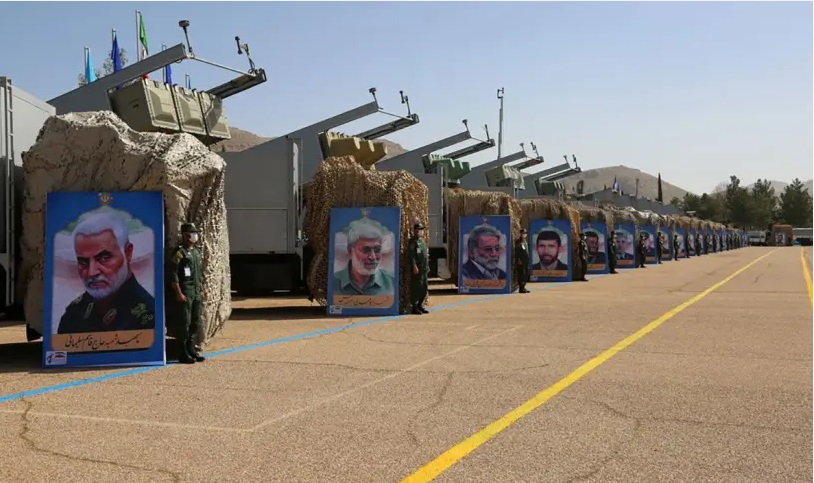Its missile arsenal was designed to be an asymmetric kind of threat because Iran has a weak conventional army and weak air force.
ran’s massive missile arsenal is growing and combined with its drones and cruise missiles makes for a destabilizing force multiplier, the International Institute for Strategic Studies said Tuesday in a report.
“Iran’s ballistic-missile systems, supplemented by cruise missiles and UAVs, are intended not only for deterrence, but for battle, including by Iran’s regional partners,” it said. “In a new report, the IISS provides a detailed assessment of Iran’s missiles, and the manner and purposes for which it has been proliferating them.”
The IISS was founded in 1958 and is a world-leading authority on global security.
“Nuclear issues are the exclusive focus of the negotiations on the restoration of the 2015 Joint Comprehensive Plan of Action (Iran nuclear deal with world powers), which has taken place in Vienna,” the report said.
However, while Western powers are focusing on the nuclear-enrichment issue now, there is also interest in “follow-on” talks about Iran’s missile program. It is not clear if Iran is interested, since it has bragged in the past about its growing collection of missiles, their precision and ranges, and it has said they are not up for negotiation.
Iran is a world leader in ballistic missiles, alongside Russia, China and North Korea, from whom it has received know-how and collaboration.
Iran’s missile arsenal was designed as an asymmetric threat because it has a relatively weak conventional army and weak air force.
Iran has exported short-range missiles to its proxies in the region. Iranian 107-mm. rockets have been sent to proxies in Iraq to be fired at US troops, and they have been seized in the past en route to Hezbollah.
Iran sent ballistic missiles to its proxies in Iraq in 2018 and 2019, according to reports. It has moved missiles and kamikaze drones and technology to Yemen’s Houthi rebels. They have used these to strike deep into Saudi Arabia at ranges of almost 1,000 km.
Iran used cruise missiles and drones to attack Abqaiq, Saudi Arabia, in September 2019. It used its Fateh-110 missiles to strike Kurds in Koya in 2018. Last year, it used its Qiam ballistic missiles to attack US forces at Ain al-Asad airbase in Iraq after the US killed Islamic Revolutionary Guard Corps Quds Force head Qasem Soleimani.
“To inform the public policy debate on the latter matters, the IISS has produced a fact-rich technical assessment of Iran’s current missile and uninhabited aerial vehicle (UAV) capabilities and its proliferation of these technologies to Iran’s regional partners,” the report said, adding that it has drawn exclusively from open sources to document some 20 types of missiles. “For now, all of Iran’s ballistic missiles apparently adhere to a self-imposed range limit of 2,000 km. Iran’s priority is to improve precision, notable in several missile systems. “
The report also looks at Iran’s “missile doctrine.” This is important to understand Iran’s long-term plans to threaten the region with its array of missiles.
Iran now focuses on “improved precision to be able to deny potential foes their military objectives,” the report said. “Iran’s missile proliferation efforts have profoundly destabilizing consequences for the region because they serve as powerful force multipliers for unaccountable non-state actors, the IISS report concludes.”
The IISS warns that Iran has supplied these systems to others.
This “demonstrate [s] a greater willingness to take risks, as well as a more offensive outlook for Iran’s missile program in general,” it said.
The report looks at Iran’s drones in conjunction with the missile threat.
“Iran is expanding its capacity to strike across the region through the continuing development and introduction of armed UAVs and cruise missiles,” the report said. “For example, in September 2019, the 700-km.-range 351 / Quds-1 missile was used to strike the Saudi Aramco Khurais oilfield facility; the attack was claimed by Yemeni Houthi rebels but likely planned and executed by Iran.
“Iran uses four complementary strategies to provide its non-state actor allies with UAVs, artillery rockets and ballistic missiles: direct transfers, upgrades to existing missiles and rockets, the transfer of production capabilities, and provision via third parties.”
IISS claims that “the advances made over the past decade on the Shahab-3, Ghadr-1 and Safir programs suggest that Iran has developed and applied a rigorous engineering-management process to organize its efforts and created the industrial infrastructure to support liquid-fuel missile production. “
This should be a wake-up call for the region and countries that are negotiating with Iran, because the missile and UAV threat will only grow in the coming years.
JS.POST








More Stories
Pakistan Retaliatory Strikes In Iran, Day After Warning of “Consequences”
Houthi rebels carrying out attacks in the Red Sea at the behest of China and Iran?
india maldives dispute: How India is helping Maldives dream big